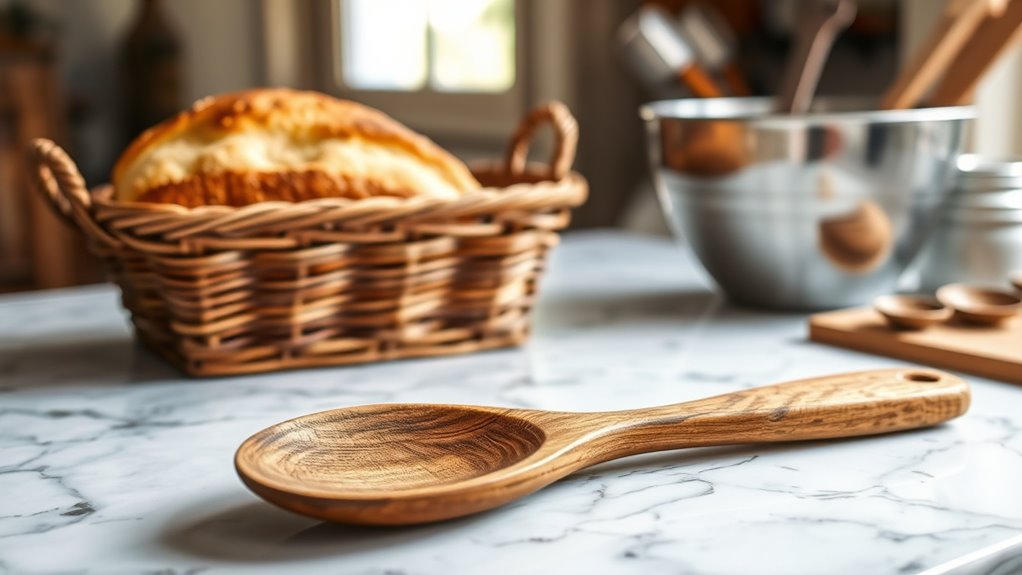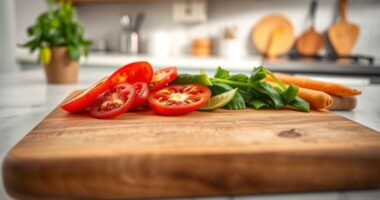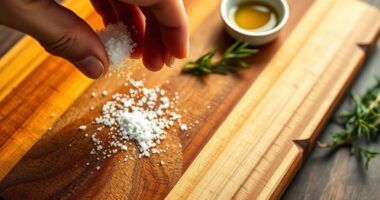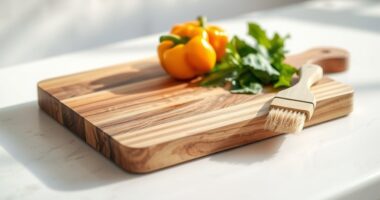To succeed with baking using wooden utensils, guarantee they are properly cleaned, dried, and oiled regularly to keep them smooth and durable. Use gentle, hot water and avoid soaking, and buff out any fuzziness or rough patches with fine sandpaper. Store them in a dry, ventilated space to prevent warping. Proper maintenance prolongs their life and ensures safe, effective use. Keep exploring for expert tips to master your baking with wooden tools.
Key Takeaways
- Use wooden spoons for gentle mixing and folding to prevent scratching bakeware surfaces.
- Regularly clean and oil wooden utensils to maintain smoothness and prevent bacteria buildup.
- Avoid soaking or dishwasher cleaning; hand wash with hot, soapy water and air dry thoroughly.
- Store in a dry, ventilated area to prevent moisture absorption and warping.
- Lightly sand and re-oil worn utensils to restore surface smoothness and extend lifespan.
Proper Cleaning Techniques for Wooden Utensils
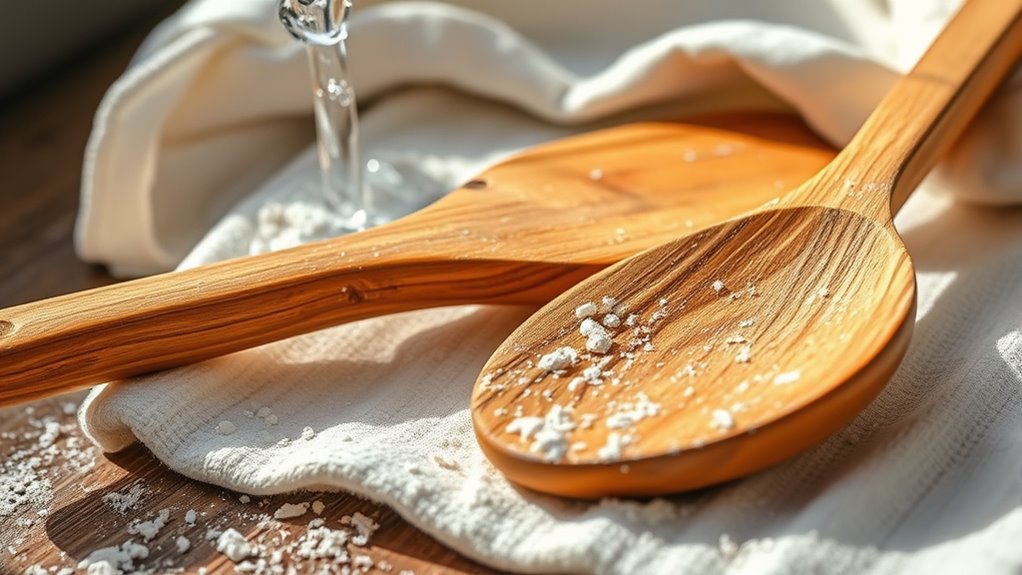
To keep your wooden utensils in good condition, you should hand wash them with hot, soapy water and use the abrasive side of a sponge to remove food residues effectively. Proper care for wooden involves avoiding soaking or immersing your utensils in water for long periods, as this can cause warping and cracking. After cleaning, rinse thoroughly to remove all soap traces, then let them air dry on a towel or drying rack. Never use harsh cleaning agents or steel wool, as these can damage the wood surface. Regular cleaning and sanding help maintain smoothness by removing fuzziness or rough patches. Additionally, understanding proper cleaning techniques can extend the lifespan of your utensils and ensure they remain safe for food preparation. Incorporating sustainable materials in cleaning and maintenance promotes eco-friendly practices and preserves the natural quality of your wooden tools. Using appropriate cleaning tools ensures effective yet gentle cleaning, preventing damage. Applying a food-safe oil regularly can also help prevent drying out and cracking, further extending their usability. Moreover, choosing non-toxic cleaning products contributes to a healthier kitchen environment and supports overall safety. Once clean and smooth, apply a food-safe oil to preserve the wood and keep your utensils looking their best for years to come.
Recognizing and Addressing Surface Fuzziness and Grain
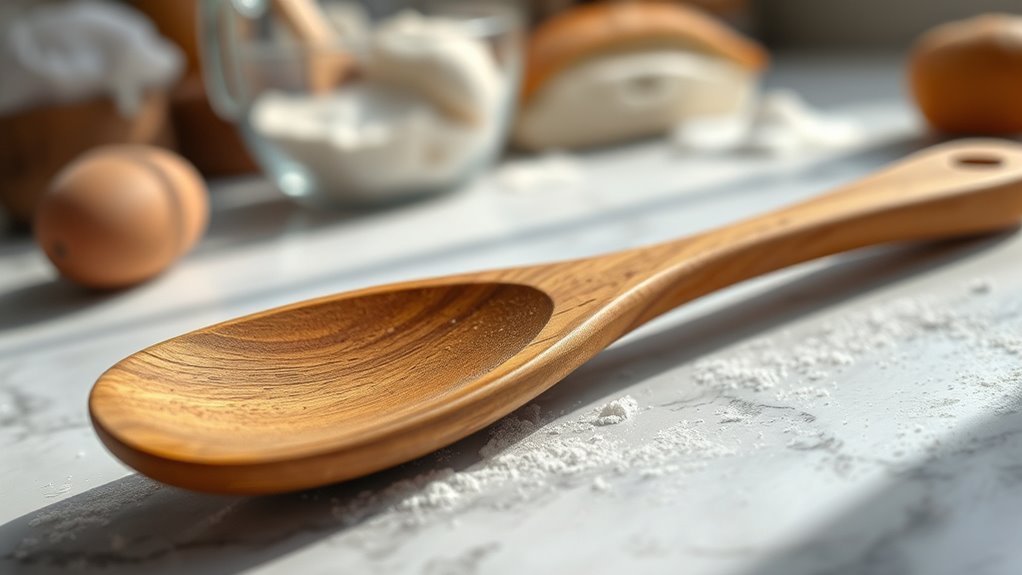
Over time, wooden utensils can develop surface fuzziness and uneven textures, often caused by water penetrating the wood pores, leading to raised grain. To recognize this issue, look for rough patches or fuzzy spots on your utensils. When you notice these signs, take action to restore smoothness:
- Use a fine Scotch-Brite pad, gently buffing in the direction of the grain.
- For heavily worn utensils, sand lightly with fine-grit sandpaper.
- Always clean off dust and debris thoroughly after sanding or buffing.
- Regular maintenance, like gentle sanding and oiling, prevents fuzziness from returning.
- Incorporating proper cleaning and drying techniques can also help prevent water penetration and surface issues.
Addressing raised grain promptly keeps your wooden utensils smooth, functional, and beautiful, ensuring they’re always ready for baking and cooking success.
The Best Oiling Practices to Keep Your Utensils Smooth and Durable

Applying the right oil is essential for maintaining your wooden utensils’ smoothness and durability. Use a generous amount of food-safe mineral oil or lemon peel oil to thoroughly coat all surfaces of your wooden tools. Let the oil soak in overnight to maximize absorption, which helps protect the wood from moisture and wear. After soaking, wipe off any excess oil to prevent a sticky or greasy finish. Reapply oil whenever your utensils look dry or dull to keep them smooth and prevent cracking. Regular oiling creates a protective barrier against moisture, bacteria, and damage, extending the life of your wooden utensils. Proper maintenance with oil is key to ensuring your utensils stay in excellent shape, ready for all your baking adventures. Additionally, understanding the financial impact of related industries highlights the importance of durable and well-maintained tools in professional settings. To further enhance their longevity, consider regular inspections to identify early signs of wear or damage and address them promptly. Incorporating nutritional benefits of using natural oils can also help maintain the safety and hygiene of your utensils over time.
Avoiding Common Mistakes That Damage Wooden Tools

Many common mistakes can quickly damage your wooden tools if you’re not careful. When using wooden spoons, avoid these errors to keep them in top shape: 1. Soaking them in water for too long, which causes swelling, warping, and cracking. 2. Putting wooden spoons in the dishwasher, where heat and moisture weaken the wood’s structure. 3. Using abrasive scrubbers or harsh cleaners that scratch or degrade the surface of your wooden spoons. 4. Storing them in humid environments without proper drying, risking mold and decay. Additionally, sound vibrations are believed to enhance cellular regeneration and overall health, so incorporating gentle sound therapy practices can promote the longevity of your tools. Proper air quality can also help prevent mold growth and maintain the integrity of your wooden utensils. Maintaining optimal humidity levels in your kitchen environment can further prevent issues related to moisture damage. Incorporating regular maintenance routines can further extend their lifespan and keep them looking new. Ensuring good air circulation around your utensils reduces moisture buildup and prevents mold development.
Selecting the Right Supplies for Maintenance and Restoration
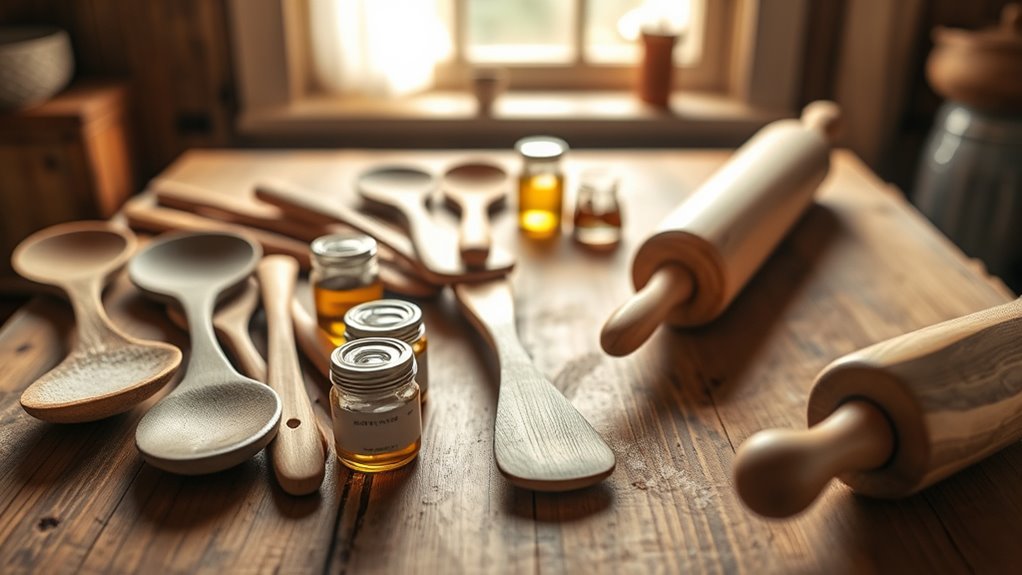
To keep your wooden utensils in top condition, selecting the right maintenance supplies is key. Use food-safe mineral oil or specialized wood utensil oils like Earlywood Oil to nourish your wooden spoons and other wooden utensils. Apply a generous coat, let it soak in overnight, then wipe off any excess for ideal hydration and shine. Incorporate wood wax into your routine to seal the surface, providing a barrier against moisture and stains. Regular reapplication is essential, especially on utensils that appear dry or dull, to extend their lifespan. Always follow manufacturer instructions or trusted tutorials to ensure even coverage and long-lasting results. Additionally, automotive paint sealants can offer a protective layer that prevents stains and damage, helping your utensils stay pristine longer. With the right supplies, your wooden spoons and utensils stay functional, beautiful, and ready for baking success.
Storing Wooden Utensils to Prevent Warping and Cracking
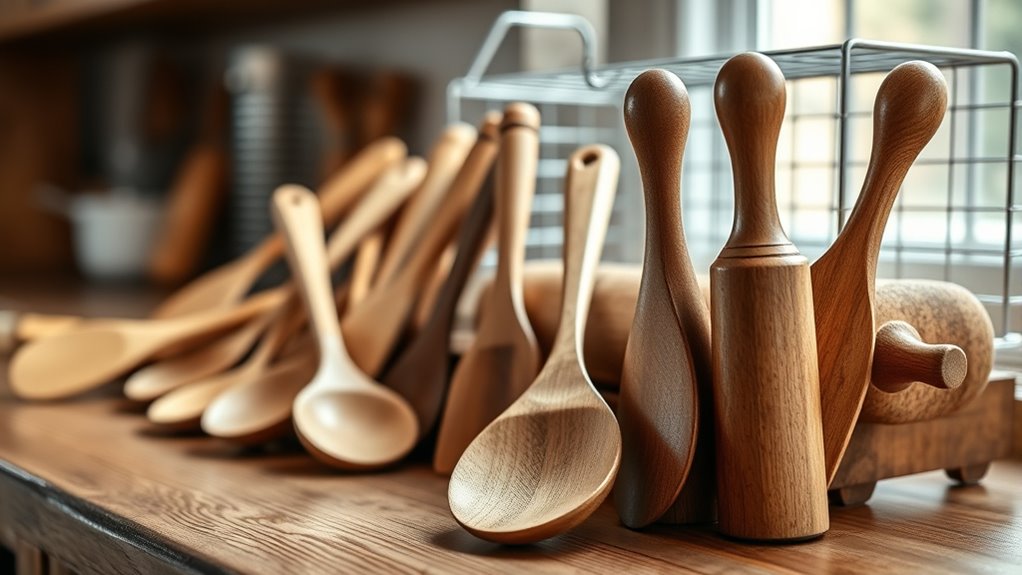
To keep your wooden utensils in good shape, store them in a dry, well-ventilated spot. Always avoid damp areas or enclosed spaces that trap humidity, which can cause warping and cracking. Hanging your utensils on hooks or racks helps air circulate and prevents moisture buildup. Using proper storage methods can extend the lifespan of your wooden utensils and maintain their quality over time.
Keep in Dry Area
Wondering how to keep your wooden utensils in top shape? The key is to keep in dry area. Moisture is the enemy of wooden utensils, causing warping and cracks over time. To protect your tools, consider these tips:
- Store wooden utensils in a dry, well-ventilated spot away from sinks or damp areas.
- Elevate them on a rack or hook to improve air circulation.
- Regularly check for leaks or excess moisture in your storage area.
- Always ensure your utensils are completely dry before storing.
- Using all-terrain strollers or travel-friendly options can help you transport your utensils safely when moving between environments.
- Being vigilant about moisture signs can help prevent damage and extend the lifespan of your wooden utensils.
- Incorporating proper storage techniques can further enhance the longevity of your wooden utensils.
- Remember that maintaining optimal storage conditions aligns with best practices for wooden utensil care, ensuring they stay in excellent condition for years to come. Additionally, avoiding exposure to affairs – cheating husband secrets and related scandals can help you maintain a peaceful environment, free from emotional disturbances that could impact your focus on proper care.
Use Proper Storage Method
Proper storage is essential for maintaining the integrity of your wooden utensils. When you store wooden utensils in a dry, well-ventilated area, you prevent moisture buildup that can lead to warping or cracking. Keep your utensils upright or hanging to allow air to circulate around all surfaces, reducing the risk of mold and deformation. Avoid placing wooden utensils in damp or enclosed spaces like drawers, where humidity can accumulate and damage the wood. Using a utensil holder with openings or a drying rack promotes even airflow and helps maintain their shape. Regularly inspect your stored wooden utensils for signs of warping or cracking, and let them air out completely before reuse or oiling. Proper storage ensures your wooden utensils stay in great condition for years. Additionally, storing your utensils properly can also prevent moisture build-up, which is crucial for avoiding warping and cracking over time. Incorporating appropriate storage methods can further extend the lifespan of your utensils and keep them looking their best.
Avoid Excessive Humidity
Excessive humidity can quickly damage your wooden utensils by causing them to swell, warp, or crack over time. To protect them from moisture, follow these tips:
- Store wooden utensils in a dry, well-ventilated area to prevent moisture buildup.
- Keep them away from humid spots like near sinks or damp drawers, which can lead to swelling and cracking.
- Avoid direct sunlight and high-humidity sources such as dishwashers or unventilated cabinets.
- Use a dehumidifier or silica gel packs if humidity exceeds 60%, helping control moisture levels.
Regularly check your utensils for signs of moisture or mold, and always ensure they’re fully dry before storing. Proper humidity control keeps your wooden utensils durable and safe for baking.
Restoring Older or Worn Wooden Utensils to Their Best Condition
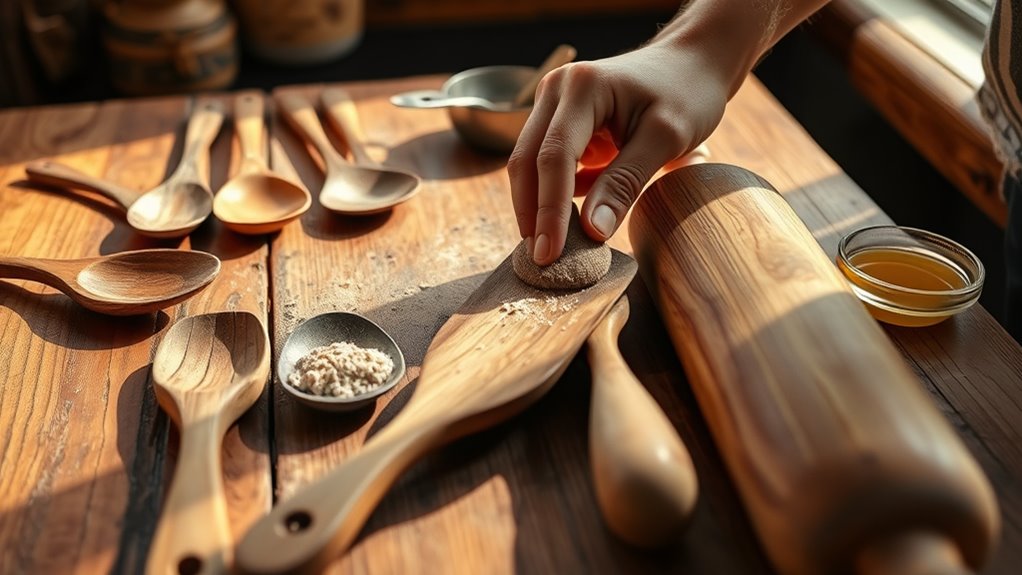
Restoring older or worn wooden utensils involves gentle cleaning and careful refinishing to bring back their smoothness and functionality. To restore your wooden utensils, start by using a fine Scotch-Brite pad or very fine sandpaper, rubbing along the grain to remove roughness and fuzziness. After sanding, thoroughly clean off all dust and debris to prevent dirt buildup and surface imperfections. Next, apply a generous amount of food-safe mineral oil or lemon peel oil, allowing it to soak in overnight to restore moisture and smoothness. For deeper grooves or rough patches, repeat light sanding and oiling as needed. Regular maintenance with oil and gentle sanding will rejuvenate your wooden utensils, prevent deterioration, and extend their lifespan, ensuring they stay functional and beautiful for years to come.
Tips for Incorporating Wooden Utensils Into Your Baking Routine
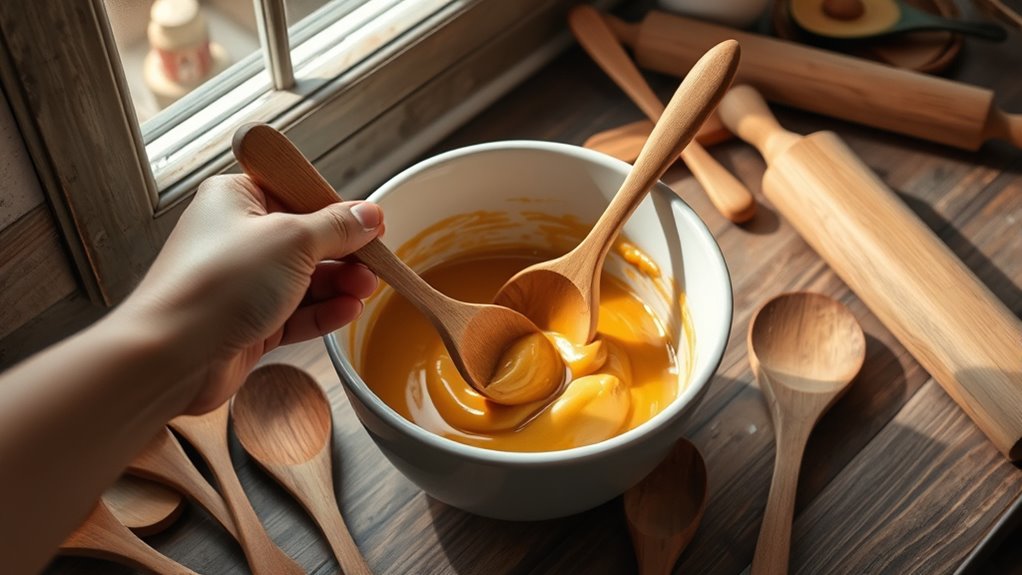
Incorporating wooden utensils into your baking routine can enhance both the quality and safety of your baked goods. Wooden spoons are perfect for mixing and folding dough gently, preventing scratches on your bakeware. Use them when stirring hot sugar or caramel mixtures, as they resist heat and won’t melt like plastic tools. To keep your kitchen utensils in top shape, regularly oil and clean your wooden spoons—this prevents bacteria buildup and maintains their effectiveness. Choose sturdy, well-crafted wooden utensils made from maple or olive wood, designed to withstand vigorous mixing and scraping. Store your wooden utensils in a dry, well-ventilated area to avoid moisture absorption, warping, or cracking. These simple tips ensure your wooden spoons remain reliable, safe, and a beautiful addition to your baking routine.
Frequently Asked Questions
Do Professional Chefs Use Wooden Spoons?
You might wonder if professional chefs use wooden spoons, and the answer is yes. They prefer them because wooden utensils are gentle on cookware, durable, and heat-resistant. You’ll find chefs choosing wooden spoons for their natural feel and non-reactive qualities, which help prevent damage and contamination. Their classic look and practicality make them a staple in professional kitchens, ensuring precise control and safe handling during busy cooking or baking sessions.
How Do You Prop an Oven With a Wooden Spoon?
To prop your oven with a wooden spoon, you first select a sturdy, crack-free spoon. Place it horizontally across the door opening, ensuring it’s centered and stable. Make sure it doesn’t touch the heating elements or interfere with the door seal. Keep an eye on it during baking to confirm it stays securely in place. This simple trick helps you keep the oven slightly open safely and effectively.
What Are the Pros and Cons of Wooden Cooking Utensils?
Imagine holding a warm, smooth wooden spoon—its gentle weight comforting in your hand. Wooden utensils are gentle on cookware, preventing scratches, and they’re naturally insulating, so hot foods won’t burn your fingers. But, they can absorb odors and stains, needing regular cleaning. They’re durable enough for heavy-duty tasks but can crack or warp if overexposed to water or dishwasher heat. Balance their beauty and strength with proper care to keep them lasting.
Why Do Bakers Use Wooden Spoons?
You use wooden spoons because they’re gentle on your cookware, preventing scratches on non-stick surfaces. They don’t conduct heat, so you can stir hot mixtures safely without burning your hands. Their porous nature helps absorb moisture and flavors, making them perfect for mixing doughs. Plus, wooden spoons are durable, resistant to breaking, and won’t react with acidic ingredients, ensuring your baked goods stay pure and flavorful.
Conclusion
With every gentle wipe and careful oiling, you nurture your wooden utensils into trusted partners in your baking journey. Picture them gleaming softly in the light, their smooth surfaces ready to dance through dough and batter. By respecting their needs—cleaning, storing, restoring—you keep them resilient and beautiful. Embrace these simple habits, and your wooden tools will continue to enhance your baking, adding warmth and tradition to every delicious creation.
